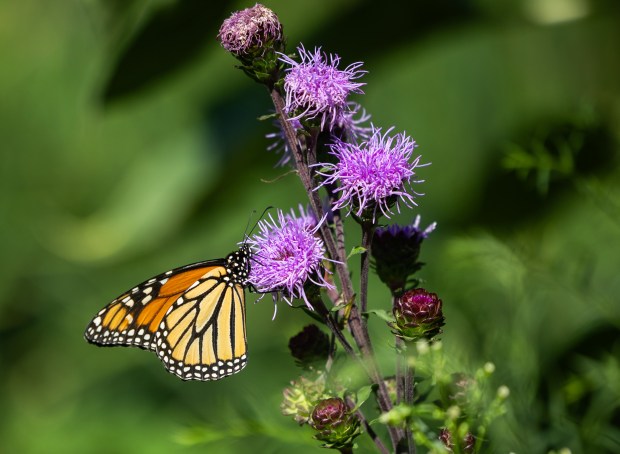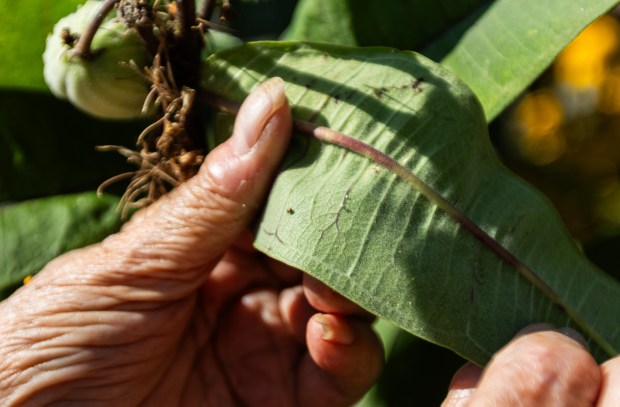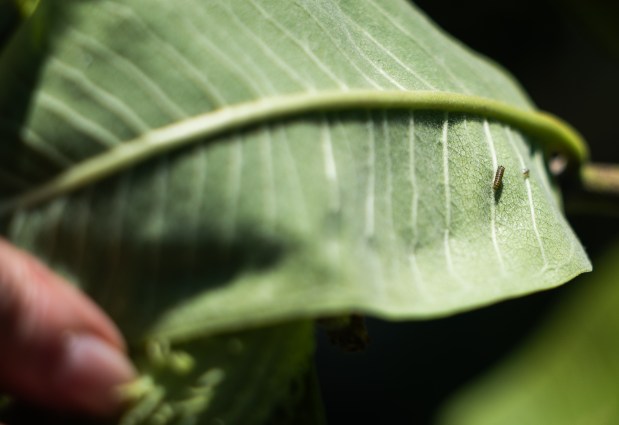When Lorraine Kells first came upon these two sprawling Chicago Park District flower beds near Diversey Harbor, she saw weeds and cigarette butts.
But eight years later, a dazzling array of wildflowers grows here: coneflower, black-eyed Susan, bee balm, spiderwort, milkweed, goldenrod, blazing star and joe-pye weed.
During a recent visit, Kells, who started the garden and now tends it with a crew of volunteers, gently turned over milkweed leaves, finally revealing a pale monarch butterfly egg — so small it was barely visible — and then a tiny black and gold caterpillar. Later, a flutter of big orange and black wings announced a more mature visitor.
“Oh! There’s our monarch again!” Kells said. “Here she comes.”
Such gardens are at the heart of a new Field Museum study, which draws on the work of Chicago-area citizen scientists such as Kells to determine how to maximize the success of imperiled monarch butterflies in small urban and suburban gardens.
The study of 450 local milkweed patches found that several strategies were associated with finding more monarch eggs: planting common milkweed, having milkweed that’s at least five years old, having more milkweed plants, planting swamp milkweed and having an array of nectar-producing flowering plants.
“The biggest thing is if you can, plant native milkweed species — ideally pesticide free,” said Karen Klinger, a geographic information systems analyst at the Field Museum and the study’s lead author. “The Illinois Native Plant Society has a great list of nurseries and plant sales. But also, very important too, is the range of blooming flowers that are blooming throughout the season. That will help monarchs as well as other pollinators.”
The study, published in Frontiers in Ecology and Evolution in July, is unusual in that it looks at relatively small urban gardens, of the kind found in Chicago and its suburbs, according to co-author Aster Hasle, a lead conservation ecologist at the Field Museum.
“This tells us what milkweed gardens look like and how monarch eggs are showing up in real life in actual urban places,” Hasle said.
Using monitoring data from citizen scientists, the researchers found that eggs were observed in 340 of the 450 milkweed patches, with the peak egg count — per monitoring session, per patch — ranging from 1 to 170.
For the milkweed patches that were five years old or older, a whopping 95% contained eggs. That compared with 61% for patches planted in the current year.
Most of the gardens were in Cook County, and they included community garden beds with milkweed such as Kells’, as well as patio gardens, balcony gardens, backyard gardens and rooftop gardens.
“We do have people who were literally in downtown Chicago,” said Klinger. “They have a rooftop deck on their condo and we have this picture that has five large caterpillars in these planters on the rooftop deck. But then you do have people who are out in the suburbs — even some of the rural areas of larger Chicago. (We had) someone who had 500 plants.”
The study was a big lift, both for the researchers and the gardeners. Participants in the study had to count the number of eggs on the undersides of their milkweed leaves, a task that involves crouching, and squinting, often under a hot summer sun.

Citizen scientists monitored their patches anywhere from one to 18 weeks, which could have given the more frequently observed patches an unfair advantage. The study addressed that by using only patches where there were at least three monitoring sessions between June and August, and considering only the patch’s peak monitoring session in a given year.
Kells, 79, a retired teacher, continued monitoring her milkweed after the Field Museum study ended. She now contributes data to the Monarch Lava Monitoring Project.
She has 25 stalks of milkweed under surveillance, and spends an hour every Sunday examining the underside of each leaf.
“It’s a very sweaty and detailed job,” she said, but when asked why she does it, she smiled: “Why not?” she said.
A lifelong gardener with a strong interest in wildlife conservation, she said she’s drawn to this work.
“It’s fundamentally just a drive to have things thrive,” she said. “It’s in all of us, some of us just heed it.”

One of the study’s more striking findings involved the success of older patches of milkweed, the vast majority of which attracted egg-laying monarchs.
That makes sense in some ways: More established plants may be better able to handle drought conditions, for instance.
But Klinger cautioned that there may be other factors at play, for instance someone who sustains a milkweed patch for five years is likely to be an avid gardener who is spending a lot of time carefully looking for eggs. That could lead to a higher egg count.
The study found that the number of blooming flower species didn’t affect the presence or absence of eggs, but it was a significant factor in determining which patches observed the most eggs.
The payoff for adding more flowering plants made sense to the researchers, who said monarchs, which feed on flower nectar, are likely to stay in the area longer if they have a good food source — and if they stay longer, they’re likely to lay more eggs.
Among the flowering plants that were popular among the citizen scientists: butterfly milkweed, spiderwort, black-eyed Susan, geranium, purple coneflower, common milkweed, phlox and daylily.
Kells distinctly remembers how she found her pollinator garden — she used to walk by the two untended beds in 2016 and noticed their condition. She’s not as clear on exactly how she heard about the Field Museum study.
“I think I just saw something that spoke to me and got involved,” she said.
On a recent Wednesday, she arrived at her two Diversey Harbor pollinator gardens, now part of the the Lakeview Community Garden, with some of the fellow volunteers who pull weeds, water plants and collect seeds. The beds are big, both about 15 feet long, and Kells is grateful for the assistance.
“I couldn’t do this without her,” she said of Suzanne Greub, 61, a real estate broker and avid gardener who does digging, excavating and heavy lifting.
Denny McNamee, 75, a retired math teacher, was recovering from a broken arm but still showed up to help with lighter tasks.
Monarchs, which produce a “super generation” that migrates up to 3,000 miles to Mexico and California in late summer and fall, have been in decline for 20 years, spurring conservation efforts by scientists and everyday people, who grow milkweed in gardens, fields and parkways.
The butterflies, while not yet recognized as federally endangered or threatened, meet the criteria, according to the U.S. Fish and Wildlife Service.
Monarchs depend on milkweed — the plant where females lay their eggs — and have suffered from the dramatic loss of milkweed habitat in agricultural areas. The use of the herbicide glyphosate “essentially eliminated” milkweed in and around agricultural fields in the Midwest, according to the U.S. Geological Survey.
A recent high-profile study found that agricultural pesticides, including neonicotinoids, have also played a major role in the butterfly’s decline, and there are concerns about climate fluctuations and climate change.
The Eastern monarch population, which spends time in Illinois, suffered another setback this year, when estimates of the winter population in Mexico declined by 59%.
Kells said she’s discouraged by how low her recent egg counts have been but threw herself into her morning’s work.
She fondly recalled a preschool group that came to the flower beds for an insect-related educational activity: “That was herding cats — delightful cats. It was amazing.”
Over the course of an hour, an array of butterflies stopped by — a swallowtail, a bright yellow sulfur butterfly and a gray hairstreak that perched obligingly on Kells’ arm. And then, as the work was wrapping up at 11 am: the grand finale.
A female monarch had just descended on the purple blossoms of a blazing star, feeding hungrily, when Kells spotted a second pair of black and orange wings, fluttering nearby.
“Oh my gosh!” said Kells, peering at the second monarch. “And it’s a male!”
nschoenberg@chicagotribune.com





